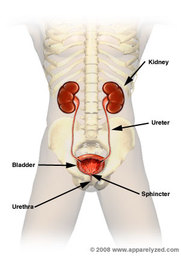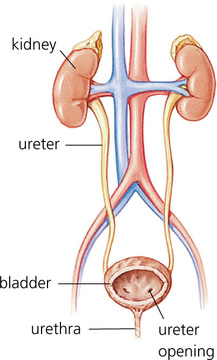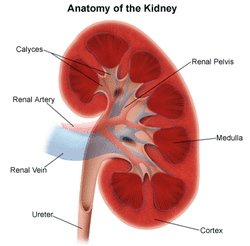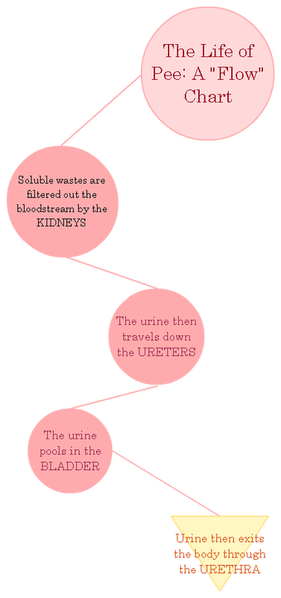Basic Information & Functions

The urinary system is the system through which nitrogenous wastes, the byproducts of metabolising proteins and nucleic acids, leave the body. Nitrogenous wastes are toxic and that is why they need to be filtered out. Water also leaves the body through the urinary system. Urea is produced when protein is broken down by the body. It is important to note tha the liver takes ammonia create from the breakdown of proteins, which is very dangerous and toxic, and converts it to urea. Urea accounts for 50% of nitrogenous waste present in urine. Other types of nitrogenous wastes are uric acid and creatinine. These two wastes are created when nucleic acid and creatine phosphate are broken down by the body. They are not as toxic as ammonia but still dangerous. The kidneys are the organ that extract out these wastes and play a vital role in the urinary system.
Breaking it down: Organs

There are 6 organs in the urinary system: 2 kidneys, 2 ureters, a bladder and an urethra.
The basic function of the kidneys is to extract and eliminate wastes while regulating the volume and composition of the body's fluids. (See below for a more indepth explanation).
The ureters are long,narrow tube-like ducts that come down, one from each kidney, and feed urine into the bladder.
The bladder is a hollow, muscular organ where urine collects after it has been filtered by the kidneys and traveled down the ureters. Once the urine is ready to be expelled, it is released from the bladder.
The urethra is a tube that connects the bladder to the outside of the body. Urine exits through the end of the urethra. The urethtral spinchter alows for control of the urethral opening.
The basic function of the kidneys is to extract and eliminate wastes while regulating the volume and composition of the body's fluids. (See below for a more indepth explanation).
The ureters are long,narrow tube-like ducts that come down, one from each kidney, and feed urine into the bladder.
The bladder is a hollow, muscular organ where urine collects after it has been filtered by the kidneys and traveled down the ureters. Once the urine is ready to be expelled, it is released from the bladder.
The urethra is a tube that connects the bladder to the outside of the body. Urine exits through the end of the urethra. The urethtral spinchter alows for control of the urethral opening.
A detailed look into the kidneys

The kidneys are bean shaped organs that are normally about the size of a fist. They are located below the ribs in the back on each side of the spine. The kidneys process blood that is fed to them renal artery. This blood is impregnated with wastes the body does not need. If these wastes were allowed to build up in the circulatory system they would cause dire problems. The actual filtration takes place in the million tube-like nephrons inside the kidney itself. In the nephron a tiny capillary called a glomerulus, intertwines witha tubule. Tubules collect urine. The glomerulus actually filters out debris while keeping normal protein and blood cells in the blood. A chemical exchange takes place and waste materials and water depart from the blood and enter the urinary system. The tubules receive a solution with chemicals the body can still use. The kidneys detect amounts of sodium, phosphorous and potassium and can release them back into the bloodstream. In addition, the kidneys secrete erythropoietin, renin and calcitriol.

